The Ultimate Whiskey Lover’s Guide to St. Louis, Missouri
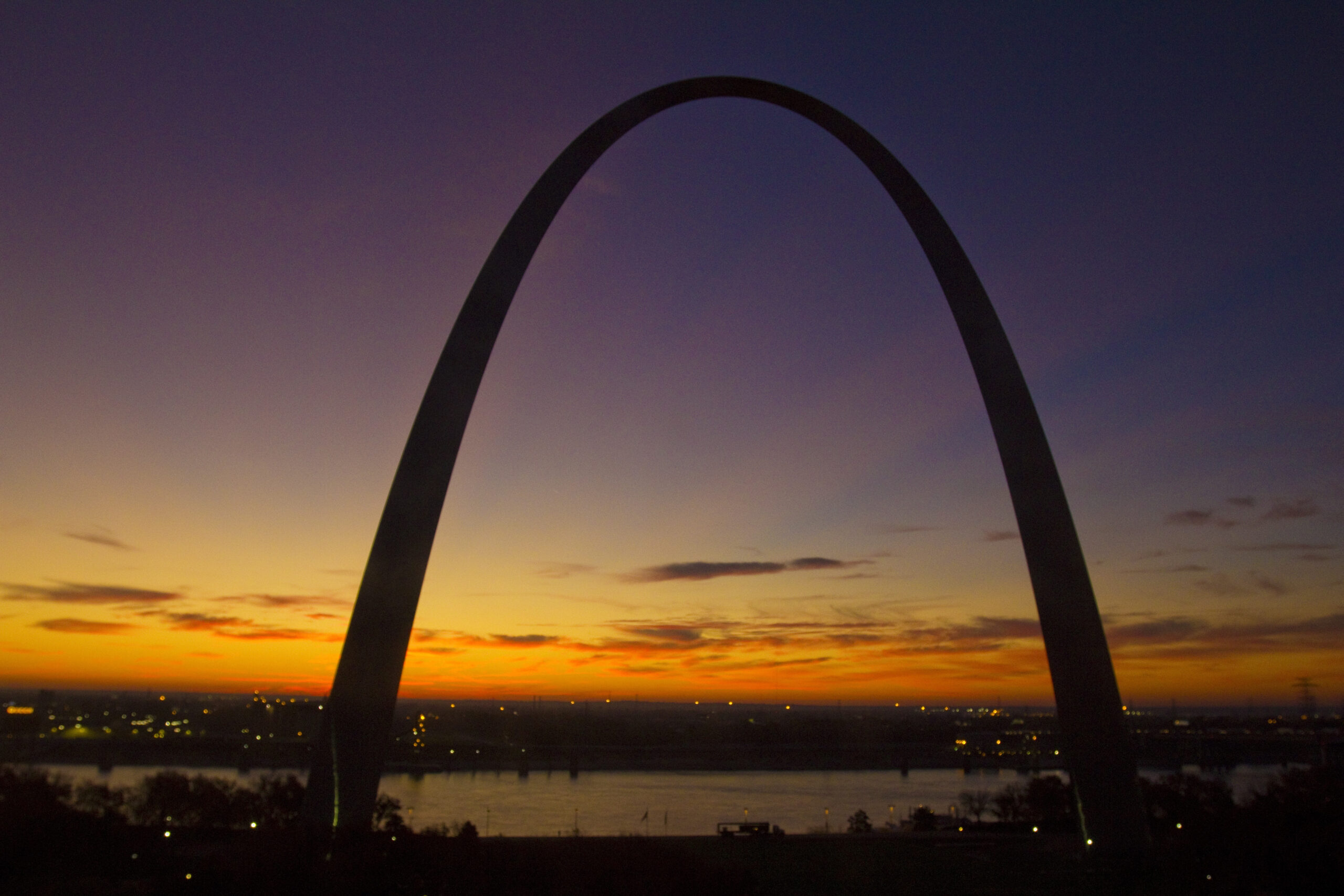
(Photo: Ken Ross / VWPics via AP Images)
St. Louis is known for many things. To name a few: the Gateway Arch, the Anheuser-Busch Brewery, the St. Louis Zoo, a great Italian food scene, some very solid barbecue and the city’s professional sports teams. Whiskey, however, isn’t something you hear associated with St. Louis very often.
But unbeknownst to many — even locals — the St. Louis area has a sneaky good whiskey scene; you just need to know where to look. St. Louis is no Louisville, but it’s quietly becoming an interesting whiskey scene — not because of size, but because of ambition, heritage, experimentation and community.
Missouri Bourbon law, enacted in 2019, is also shaping the landscape. To qualify as a Missouri Bourbon, a bourbon must be mashed, fermented, distilled, aged and bottled in Missouri, with all corn and barrels sourced from the state. That final requirement is unusual, but it works in Missouri thanks to Lebanon, Missouri’s Independent Stave Company, which is the largest barrel maker in the world.
For the whiskey heads living in or visiting St. Louis, we’re going to break down the can’t-miss spots you need to know about.
The Whiskey Producers You Need to Visit in the St. Louis Area
Nobletons Distilling House (545 Commercial Drive, Union, MO 63084)
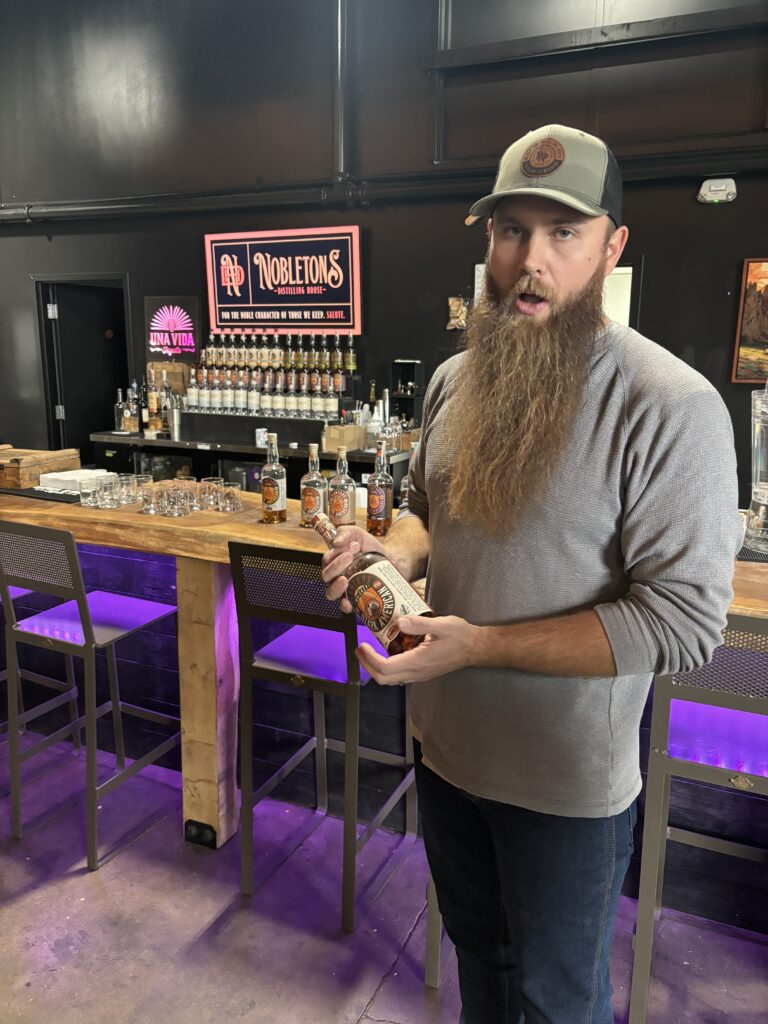
Demetrius Cain is pictured at Nobletons Distilling House.
About 50 minutes West of downtown St. Louis is Nobletons Distilling House, located in Union. It’s the work of Demetrius Cain, a ninth-generation distiller who traces his family’s mashbills back through the centuries. Cain, who describes himself as “a steward for my family’s history,” takes an estate-based approach, growing his own grains and controlling every step of production, from fermentation through bottling. He is especially known for his unusually long 48-day fermentation period. That patience produces spirits with a viscosity and oiliness that set them apart.
Another example of the tradition that has been carried over through the generations is the practice of malting every grain — very unusual. Typically, distilleries use malted barley to bring the enzymes needed to break down starch into sugars for fermentation. Caine, however, also malts his corn and rye. Why? Because that’s how his family has always done it, and it results in great whiskey, so why question it?
Nobletons is not limited to bourbon and rye. Cain also makes agricole-style rum from sugarcane juice, a rarity in Missouri, as well as gin and some very delicious apple brandy. Visitors will find both heritage bourbons based on family recipes and distinctive, experimental spirits that reflect the same commitment to depth and texture.
The traditional approach has clearly been a success, as Nobletons is our pick for the best distillery in the St. Louis area. The distillery has also built a great lounge and tasting room that’s absolutely worth the visit.
Nobletons produces and distributes two in-house whiskey labels: Planters Ozark Highlands and Copper Dome, the latter a partnership with Southeast Missouri State University. Beyond whiskey, there are also Peoples Gin and Peoples Vodka.
Wood Hat Spirits (489 Booneslick Road, New Florence, MO 63363)
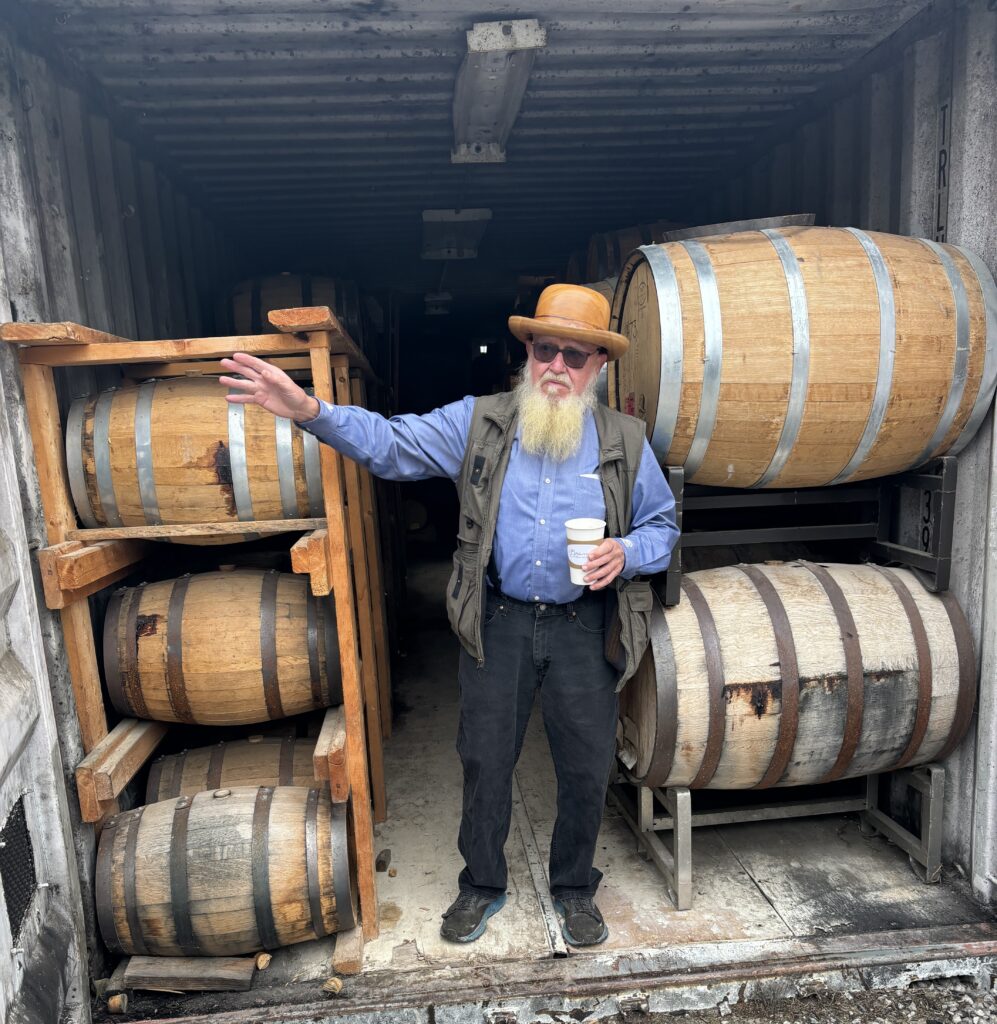
Wood Hat Spirits founder Gary Hinegardner stands with barrels of his whiskey, which are stored in shipping containers.
Travel west of St. Louis (about 75 miles from downtown) and you’ll find Wood Hat Spirits, where founder Gary Hinegardner is quietly proving himself one of America’s great grain experimenters. Hinegardner grows and distills many varietals of heirloom corns, from Bloody Butcher red to various blues, whites, yellows and oranges, arguing that each brings its own character to whiskey.
Hinegardner, an agronomist who has helped farmers grow corn on three continents, believes the whiskey industry has an immense way to go when it comes to caring about the quality and types of grains whiskey is distilled from.
“There’s just a lot of corn out there, he explained. “And it really amazed me that we make bourbon out of town pig feed.”
Hinegardner contrasts this with the wine industry: “If we were a winery, the first thing we’d talk about is the grape, because it’s so important to making wine. And we don’t even go there in bourbon.”
For that reason, he’s set out to grow and distill as many different varietals of corn as he can, in an attempt to find the best corn for bourbon. He breeds his own corn and owns the rights to the genetics of certain varietals.
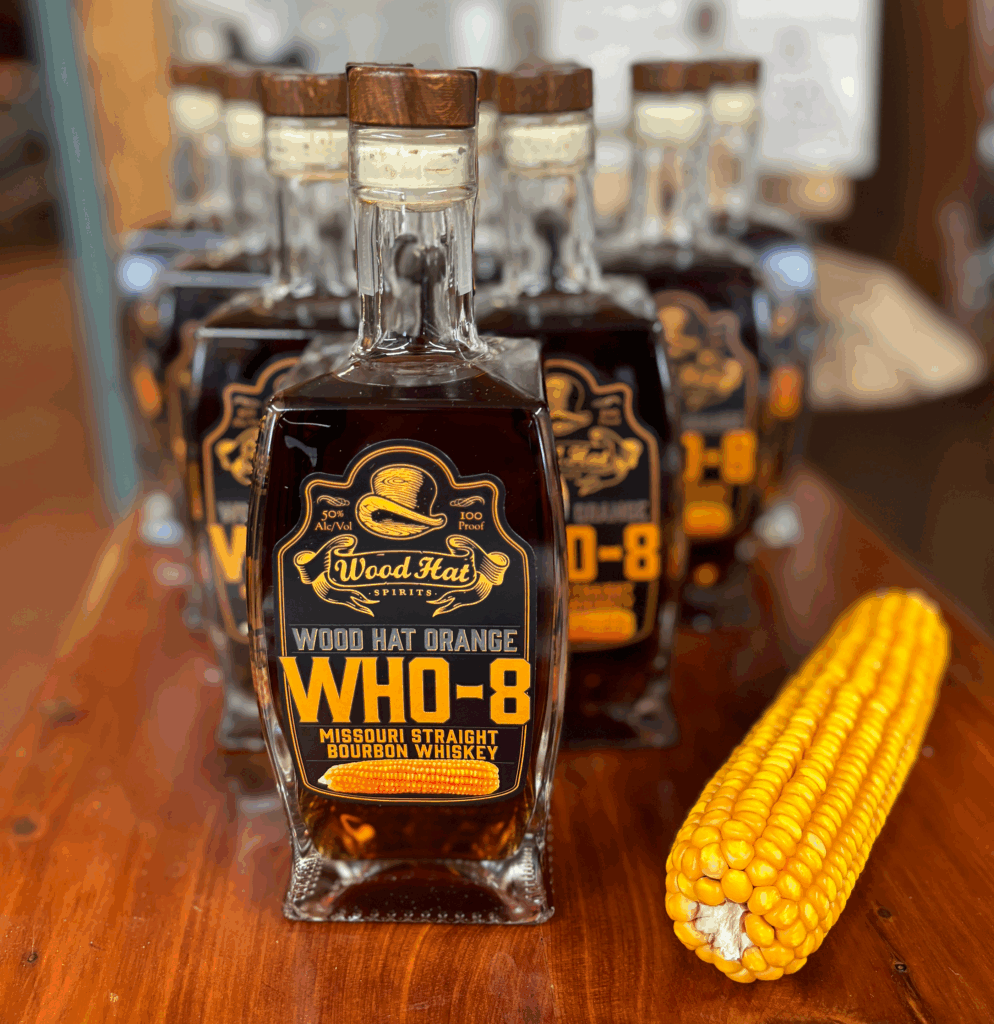
Wood Hat’s WHO-8 is distilled from a mashbill using the distillery’s proprietary orange corn.
Wood Hat’s first bourbon made from WHO-8 (stands for Wood Hat Orange #8) corn is pretty awesome stuff. It’s dark in color and has an exquisite, thick mouthfeel. “That is, the first corn bred for bourbon,” the bottle boasts. Hinegardner should be proud of his work; it’s a very good bourbon. Click here to check out our full review.
Hinegardner believes the bourbon world hasn’t gone out of its way to learn more about corn because the industry has been so successful — if it ain’t broke, right? Wood Hat is a small operation, and that’s exactly how Hinegardner wants it.
“It’s really of a research project with corn, and as long as I get enough money out of that to pay the health I’m happy,” he said. We never intended to be a big bourbon producer here.”
His experimentation extends into barrel management as well, with staves air-dried for different lengths of time and occasional use of local wood species to create unique maturation environments. Outside of being one of the most knowledgable grain experts you’ll ever meet, Hinegardner worked for 17 years at Independent Stave Company, so he knows the ins and outs of the barrel side of the industry, as well. In short, he’s a walking encyclopedia on all things whiskey.
Wood Hat ages some of its whiskeys in 15-gallon barrels — much smaller than the standard 53-gallon size. These smaller barrels essentially age whiskey faster, as the smaller surface area means each barrel of whiskey interacts with more oak. Wood hat stores these barrels in shipping containers that hold about 200 15-gallon barrels each.
Wood Hat’s whiskeys highlight the grain more than the barrel, which flies in the face of the typical approach. And if Hinegardner’s theory about the underrated importance of grain is correct, Wood Hat just might be far ahead of the curve with its approach. Twenty, 30, 50, 100 years from now, perhaps grain terroir will be viewed in the same light we think about grapes in wine today.
Whatever the future holds, Wood Hat is doing something truly different making it an essential stop for anyone who wants to learn about the ways grain shapes whiskey flavor.
And of course, we’d be remiss if we didn’t explain the name; in addition to his many other talents, Hinegardner is a woodworker, and he crafts and sells wooden hats at the distillery — a fun novelty, no doubt.
StilL 630 (1000 S 4th Street St. Louis, MO 63104)

While you need to travel a bit beyond the city limits to find Nobletons and Wood Hat (both worth the trip, mind you), StilL 630 is as St. Louis as St. Louis gets, smack in the middle of downtown, less than a mile from the Arch. In an old Hardy’s building, if you’ll believe it.
You may ask the question “Why is it called StilL 630?” And you may be surprised at how detailed an answer you receive. 630 stands for:
- June 30 was the day the distillery was founded. They throw a big anniversary party every year on “630 Day.”
- 630 also happens to be the serial number of the distillery’s first big pot still.
- The Gateway Arch is 630 feet tall and wide.
The space is small and definitely has a hole-in-the-wall vibe, but founder David Weglarz has built something special, pursuing an ambitious program that includes whiskey, rum, brandy and gin, all made on site.
As President of the Missouri Craft Distillers Guild, Weglarz led the effort to create the protected “Missouri Bourbon” category.
The coolest part of StilL 630 is its experimental spirits program, in which it ages various spirits — from bourbons to wheat whiskeys to single malts to barrel-aged gin to tequila to apple brandy to smoked whiskey to spiced rums and beyond — in small barrels. Once a month, StilL 630 releases a new experimental spirit. On Fridays, visitors can get a free taste of the latest experiment. All the distillery asks in return? Give a little feedback and answer a few questions: “Did you like it? Should we make more of it? What do you want the future to taste like?”
It’s a great way to get feedback and figure out which experiments are worth making more of.
StilL 630 operates with sustainability in mind, sourcing non-GMO grains and recycling spent grain to feed livestock. Their custom-built stills were designed based on French Armagnac design influences, allowing them to distill at lower temperatures and capture a wide range of flavors. Visitors can taste through their lineup in the downtown tasting room, which doubles as a cocktail bar (open every Friday from 5-9 p.m.) and event space, making StilL 630 one of the most accessible introductions to the area’s spirits culture.
Common Ritual (8125 Michigan Ave., St. Louis, MO 63111)
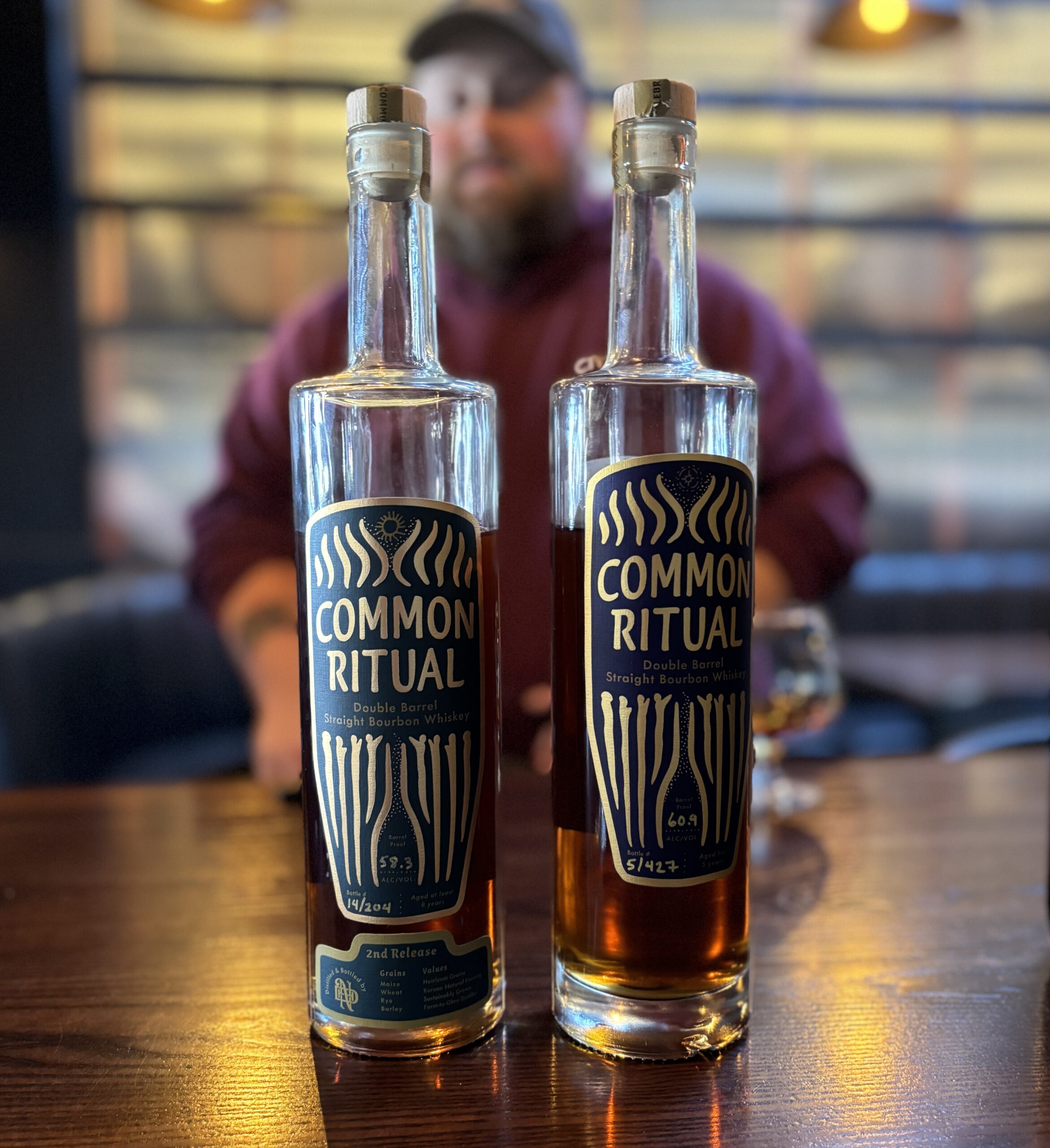
Unlike the previous three, Common Ritual isn’t a distillery. Founded by Phil Wymore and Russ Bryant of the popular St. Louis brewery Perennial Artisan Ales, the company is built around blending and bottling rather than distilling. Wymore and Bryant source whiskey from distilling partners such as Nobletons, Northern Illinois’ Kennay Farms and Upstate New York-based Taconic, then shape it in their own way.
The result has been consistently great small-batch whiskey, from bourbon to rye to apple brandy-finished American single malt and beyond. For drinkers who enjoy whiskey with layered influences and bruising proof points, Common Ritual is a must-try, and Perennial, one of America’s great stout makers, is a must-visit.
Barrel King (126 West Pine Street, Suite B Bourbon, Missouri 65441)
If you were thinking about stopping in Bourbon, Missouri, just for the novelty of the name, rest assured that Barrel King is putting the Bourbon in Bourbon, MO. A very young operation, Barrel King has wasted no time, buying barrels of whiskey from all over the country and blending them into truly interesting and distinctive expressions. Barrel King released its first bottle in 2022. The latest batch? No. 111. And that’s not even including all the barrel picks!
Shops and Bars You Won’t Want to Miss
ABV Barrel Shop (6 Fox Valley Center, Arnold, MO 63010)

Steve Akley leads a whiskey tasting in the speakeasy attached to ABV Barrel Shop.
Based in Arnold, ABV Barrel Shop plays a key role in the St. Louis whiskey scene. Operated by Steve Akley, the shop focuses on barrel picks, often in direct partnership with local distilleries. What sets ABV apart is its philosophy: Akley and his team only sell bottles from producers they know personally, ensuring that every whiskey on the shelf comes with a story. The shop also doubles as a gathering place for whiskey lovers. Tasting events, release parties and an in-store bar that ensures you can taste before you buy a full bottle make ABV Barrel Shop more than just a bottle shop — it’s a hub for education and community, connecting St. Louis drinkers with the broader craft whiskey world. The most loyal patrons join the Barrel Shop Syndicate, a members-only club.
“We don’t buy anything that we don’t know the people who made that whiskey, who distilled it, who owns the company, that type of thing,” Akley told us. “So, we’re very different. We’re educated about the products that we have.”
- The Wine & Cheese Place (Multiple locations): While better known for its expansive wine collection composed of more than 3,000 bottles, The Wine & Cheese Place is also home to more than 800 whiskeys (and more than 1,200 beers, if that’s your jam).
- Clark & Bourbon (799 Clark Ave., St. Louis, MO 63102): Clark & Bourbon is a swanky restaurant situated in the Live By Loews hotel, right across the street from Busch Stadium. We’re less focused on the food at Clark & Bourbon and more on The Whiskey Room in the back of the restaurant. Available to book for up to 12 people, the intimate Whiskey Room hosts an extensive list of 480 bottles of whiskey.
- Blood & Sand (1500 St Charles Street, St. Louis, MO 63103): Apart from its extensive cocktail menu, Blood & Sand has more than 280 bottles on its bar.
- City Park Grill (3157 Morgan Ford Road, St. Louis, MO 63116): This Tower Grove South restaurant has more than 150 whiskeys on the menu.
- Salt + Smoke (Multiple locations): This excellent local barbecue chain (locations in Ballpark Village, Delmar, Hampton, Saint Charles, Ellisville and South County) has more than 170 whiskeys on deck, from America to Canada to Scotland, Ireland and Japan.
- Planter’s House (1000 Mississippi Ave., St. Louis, MO 63104): While not having the largest whiskey list in the city, Planter’s House warrants a mention for being St. Louis’ best cocktail spot. It’s also got plenty of barrel-pick whiskeys and an impressive variety of spirits, aperitifs, digestifs and more.
- The Vandy (1301 S. Vandeventer Ave., St. Louis, MO 63110): Perfect for lovers of allocated whiskeys, The Vandy’s near-300-bottle selection includes popular labels like Weller, Blanton’s, Eagle Rare, E.H. Taylor and Stagg.
- The Brothers Beer & Bourbon House (14738 B Manchester Road, Ballwin, MO 63011): This fun shop has an array of more than 100 spirits (mostly whiskey), plus beers and sauces aplenty. The store has a bar that offers beer on tap and pours of whiskey, including its own barrel picks. Enjoy a flight of either beers or whiskeys to sample all you can.
Whiskey Events
St. Louis is also home to a few whiskey-focused events each year that are more than worth checking out:
- St. Louis Bourbon Festival: Hosted each October, the St. Louis Bourbon Festival takes over the historic Lemp Mansion in Benton Park and offers hundreds of whiskeys for attendees to sample, in addition to food trucks, live music and more.
- Pig & Whiskey: Held in May, this free-to-enter event at the 4 Hands Brewery tasting room combines barbecue and whiskey, along with local beer, cocktails and more.
- Bourbon & Brews: This June festival offers exactly what it sounds like: bourbon and beer. That and cocktails, bites from food trucks aplenty and more, all on Frankie Martin’s sprawling 3-acre “Garden Oasis” in Cottleville. Learn more.
Follow The Daily Pour:
About The Daily Pour
Founded by Dan Abrams, The Daily Pour is the ultimate drinking guide for the modern consumer, covering spirits, non-alcoholic and hemp beverages. With its unique combination of cross-category coverage and signature rating system that aggregates reviews from trusted critics across the internet, The Daily Pour sets the standard as the leading authority in helping consumers discover, compare and enjoy the best of today's evolving drinks landscape.
